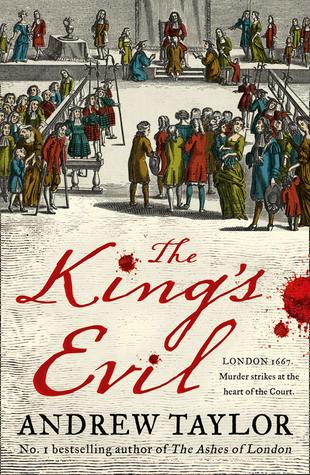
TEST
The King’s Evil is the third book in Andrew Taylor’s series of historical mysteries set in and around Restoration London in the year or so following the Great Fire of 1666. As was the case with the previous two books – The Ashes of London and The Fire Court – this latest release in the Marwood and Lovett series is a detailed and intricately plotted historical mystery in which the author vividly evokes the sights, sounds and smells (!) of post-Fire London, putting the reader firmly amid the filthy, crowded streets occupied by the ordinary folk trying to eke out an existence and clearly setting out the political posturing and jostling for position rife throughout Charles II’s court. I was pulled into the story right away and was fully engrossed, eagerly turning the pages right until the end.
It’s been over a year since London burned, and James Marwood has come a long way from the humble clerk he was when we first met him. He’s prospering in the employ of two masters, one of whom, Mr. Chiffinch, is Keeper of the King’s Private Closet and Page of the Backstairs, one of the most powerful men at court because he controls private access to the king. Chiffinch directs Marwood to investigate a murder which occurred at the London home of the former Lord Chancellor, Lord Clarendon, who has recently fallen from favour, but who nonetheless retains some influence at court owing to the fact that one of his daughters is married to the king’s brother, James, Duke of York.
When the book opens, Marwood is attending a ceremony at Whitehall wherein the king lays hands on those suffering from the King’s Evil, or scrofula, (a disease we now call tuberculosis); it was believed that the monarch’s touch could heal the disease. Marwood has been directed there in order to meet with Lady Quincy (formerly Mistress Alderley and Cat Lovett’s aunt) and to do as she directs; during their conversation she tells him that her stepson, Edward Alderley, has discovered Cat’s whereabouts and is intent on taking his revenge upon her for the wound she inflicted on him when she attacked him before fleeing the family home. Marwood and Cat met on the night of the fire and have formed an odd friendship (of sorts); they’ve saved each other’s lives and have worked together on a couple of investigations, but she has never revealed the reason she left her home. When Marwood tells her about Alderley and urges her to leave London for a while, she finally tells him the truth – her cousin raped her and she went for him with a knife (and he lost an eye as a result) – and Marwood is sickened by her tale. Cat, who is a talented draughtsman but is precluded from following that profession because of her sex, is pursuing it in secret while also hiding behind the identity of Jane Hakesby, cousin and maidservant to the architect Simon Hakesby, a much older and feeble man whose offer of marriage Cat has accepted, seeing it as a way of achieving safety and financial security.
She’s a prickly young woman – intelligent, fiercely independent and unwilling to show weakness – and at first she is at first adamant that she won’t leave London. And by the time, a few days later, Marwood discovers she has left after all, the situation has become a lot worse, because Alderley’s is the body found at Clarendon House – drowned in a well – and Hakesby was one of the architects supervising the building work currently underway in the grounds. It doesn’t take long for suspicion to fall upon Cat – but Marwood can’t believe she’s guilty of murder, and chooses to keep his connection with her to himself while he tries to find out who killed her cousin, even though he knows that trying to keep Cat safe and proving her innocence may well prove dangerous for him.
Cat’s involvement in this novel is somewhat smaller than in the earlier books, but her presence is strongly felt throughout as Marwood struggles with divided loyalties and to see clearly through the web of lies and manipulation that are being woven around him. He faces some of his toughest challenges yet as he is subjected to the manipulations and orders of those in positions of power and has to use all his wit and skill to carefully pick his way through the political minefield facing him, while somehow retaining the compassion and personal integrity that marks him out as different from so many of those around him. Part of that minefield is the complication added by his infatuation with the calculating but lovely Lady Quincy, especially when Marwood pieces all the clues together – which point towards the existence of a treasonous conspiracy.
Although the third in a series, the novel can be read as a standalone; I’d suggest, however, that readers will better understand the complicated relationship between Marwood and Cat by reading the first two books as well (and they’re both excellent, so that’s definitely recommended).
The King’s Evil is a fast paced, densely plotted and full of fascinating historical detail that brings Restoration London vividly to life in all its splendid, ugly glory. It’s a terrific read, and one I found hard to put down; fans of historical mysteries won’t want to miss it, and I’m eagerly awaiting Marwood and Lovett’s next investigation!
Buy it at: Amazon/Apple Books/Barnes & Noble/Kobo
Visit our Amazon Storefront or shop at your local independent bookstore
Grade: B+
Book Type: Historical Fiction
Sensuality: Subtle
Review Date: 09/12/19
Publication Date: 04/2019






Recent Comments …
Yep
This sounds delightful! I’m grabbing it, thanks
excellent book: interesting, funny dialogs, deep understanding of each character, interesting secondary characters, and also sexy.
I don’t think anyone expects you to post UK prices – it’s just a shame that such a great sale…
I’m sorry about that. We don’t have any way to post British prices as an American based site.
I have several of her books on my TBR and after reading this am moving them up the pile.